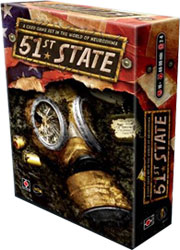



play board games
Board game reviews, strategy tips & session reports
51st State Review
 Stats:
Stats:
No. of players: 2-4
Amount of time to play: 40-90 min
Age requirements: 10+
Set-up time: 5 minutes
51st State Rules Description:
51st State is a card game set in the post-apocalyptic world of Neuroshima. In order to win, you’ll need to manage your workers and resources to build a better city and earn more victory points than your opponents.
51st State is a pretty complex game to learn. But once you have the gist of it, the gameplay is pretty straightforward.
To begin each player selects one of four different factions. Each faction has their own strengths and weaknesses. So part of your strategy will be based on which faction you are.
You begin the game with your faction’s base, contact cards and four cards. Contact cards help you grow your city and are unique to each faction. One contact card helps you gain Spoils, one helps you make Deals and the other helps you place Locations.
Most of the cards can be used in one of three ways. Spoils (highlighted in red at the top of the card) give you a one-time benefit. Deals (highlighted in blue at the bottom of the card) you are able to use every turn but usually give you less stuff than Spoils. Locations (the center area of the card) you add these to grow your city. They give you VPs resources and other actions.
Your turn consists of five phases: Lookout, Production, Actions, VP count, and Clean-up.
During Lookout phase you draw one card from five in a common area. In clockwise order each player then takes a card (depending on the number of players this selection may get refilled). Each player chooses two total cards they can see and then draw one card from the face-down draw pile. Any card left in the common area is discarded.
Next any Production cards you have produce workers and resources. Based on which faction you are playing, you start the game producing a different resource. Some Locations in your city or Deals you have made add to the resources and workers you produce. During the Production Phase is also when you take resources and cards from Spoils.
There are many actions you may take in the Actions Phase. Most involve adding Locations, making Deals or gaining Spoils. You must have the allotted resource(s) to use a contact card and may only do so once per turn.
Replacing leaders and renovating buildings are two other important actions that help you gain extra VPs. Renovating buildings are a cheap way to get higher cost Locations into play.
You may also place your workers on your buildings (or others if they are open) to take actions that help you gain VPs, resources or more workers.
VP count is exactly what you think it is. Each player adds up their VPs and adjusts their score. Each leader and building in play is worth 1 VP. You may also have VPs on your base from renovating a building or replacing a leader. This score is not cumulative and is just recalculated every round.
In the Clean-up Phase you must discard all your resources and workers whether you used them or not.
Play then proceeds with the player on your left starting their Lookout Phase.
Once any player has scored 30 or more VPs, the player with the most wins the game.
A Quick Review of 51st State:
51st State is very comparable to Race for the Galaxy, but the theme is different as are some of the mechanics. You must learn the iconography and be aware of the different cards to understand the game. There is a learning curve and it will probably take you a couple games to get the hang of 51st State.
It is worth it though. I am not sure it will get played as much as Race for the Galaxy as my wife loves to play RftG, but 51st State is still a very good game. The theme really stands out and there are some nice mechanics to it.
First having different factions and giving them different strengths and weaknesses is great. It adds variety, replayability and allows you to develop different strategies to win.
Though not a deck-building game, there is a slight element of drafting during the Lookout Phase. The cards you draft will help determine your strategy and can make or break your game.
Also the mix of card game with worker placement is unique and done very well. You’ll have to decide the best way to utilize your workers for resources and VPs.
The scoring track is on the back of the box which is kind of weird. You can download and print one out from the official site so this isn’t too big of an issue. I wish 51st State had cheat sheets with the phases, actions and iconography spelled out. There is a short cheat sheet on the printable scorecard so I highly recommend using it.
51st State even has official solo rules that are fun and can help you to learn the intricacies of the different factions and Locations.
The game only takes 4-8 rounds but beware of analysis paralysis. Since each card can be used three different ways, there are many decisions to make and you may be waiting for your turn.
If you are willing to learn the rules and iconography of 51st State you will be rewarded. This game is fun and innovative.
Score and synopsis: (Click here for an explanation of these review categories.)
Strategy 4 out of 6
Luck 4 out of 6
Player Interaction 3 out of 6
Replay Value 4 out of 6
Complexity 5 out of 6
Fun 5 out of 6
Overall 5 out of 6

Leave a Reply